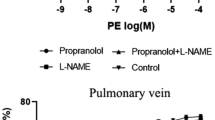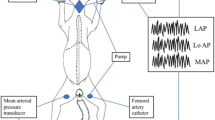Abstract
The goal of this study was to determine the in vivo pulmonary arterial buffering function (BF) during acute and moderate pulmonary hypertension achieved by phenylephrine-induced smooth muscle activation.
Pulmonary pressure (Konigsberg P7) and diameter (sonomicrometry) were measured in nine anesthetized sheep. Transit pulmonary arterial hypertension was induced by mechanical occlusion of the pulmonary artery (HP) and by phenylephrine infusion (5 μg/kg/min) (PHE). A viscoelastic Kelvin-Voigt model was used. By increasing the values of the viscous modulus, the pressure-diameter hysteresis area was reduced to a minimum in order to obtain the purely elastic pressure-diameter relationship. The elastic index (E) was calculated as the first derivative of the exponential model of the purely elastic pressure-diameter relationship at the mean pressure point.
Systolic, diastolic, mean and pulse pressures were similar during HP and PHE, but significantly higher with regard to control steady state. In HP, E and arterial diameter (both its minimum and maximum values) increased significantly. In contrast, when pulmonary hypertension was induced by VSМ activation, E was maintained concomitantly with pulmonary artery vasoconstriction.
Pulmonary hypertension produced by occlusion of the pulmonary artery increases elasticity. Smooth muscle activation may offset the deleterious effect of pulmonary hypertension on arterial wall elasticity by reducing E and impeding arterial dilatation and collagen recruitment, maintaining BF during pulmonary hypertension. (Mol Cell Biochem 246: 19-24,2003)
Access this chapter
Tax calculation will be finalised at checkout
Purchases are for personal use only
Preview
Unable to display preview. Download preview PDF.
Similar content being viewed by others
References
O’Rourke MF: Arterial Function in Health and Disease. Churchill Livingstone, New York, 1982
Nichols WW, O’Rourke MF: McDonald’s Blood Flow in Arteries: Theoretical, Experimental and Clinical Principles, 3rd edn. Edward Arnold, London, 1990, pp 125–142 and 381–397
O’Rourke MF: Second workshop on structure and function of large arteries. Part I. Mechanical principles in arterial disease. Hypertension 26: 2–9, 1995
Simon A, O’Rourke MF, Levenson J: Arterial distensibility and its effects on wave reflection and cardiac loading in cardiovascular disease. Coron Artery Dis 2: 1111–1120, 1991
O’Rourke MF, Avolio AP, Nichols WW: Left ventricular-systemic arterial coupling in humans and strategies to improve coupling in disease states. In: F.C.P. Yin (ed). Ventricular Vascular Coupling: Clinical, Physiological and Engineering Aspects. Springer-Verlag, New York, 1987, pp 1–19
Milnor WK: Hemodynamics. Williams & Wilkins, Baltimore, 1982, pp 56–96
Dobrin PB, Rovick AA: Influence of vascular smooth muscle on contractile mechanics and elasticity of arteries. Am J Physiol 217: 1644–1652, 1969
Barra JG, Armentano RL, Levenson J, Cabrera Fischer EI, Pichel RH, Simon A: Assessment of smooth muscle contribution to descending thoracic aortic elastic mechanics in conscious dogs. Circ Res 73: 1040–1050, 1993
Armentano RL, Barra JG, Levenson J, Simon A, Pichel RH: Arterial wall mechanics in conscious dogs: assessment of viscous, inertial, and elastic moduli to characterize the aortic wall behavior. Circ Res 76: 468–478, 1995
Cox RH: Viscoelastic properties of canine pulmonary arteries. Am J Physiol 246: Н90-Н96, 1984
Cox RH: Comparison of mechanical and chemical properties of extra-and intralobar canine pulmonary arteries. Am J Physiol 242: 245–253, 1982
Bevan JA, Johnson RC, Verity MA: Changes in elasticity of pulmonary reflexogenic area with sympathetic activity. Am J Physiol 206: 36–42, 1964
Evans JN, Little B, Doyle JM: Mechanical properties of isolated pulmonary arterial vessels. Physiologist 23: (abstr) 76, 1980
Hoffman BB, Lefkowitz RJ: Alfa-adrenergic agonists, sympathomimetic drugs and adrenergic receptors agonists. In: J.G. Hardman, L.E. Limbird, P.B. Molinoff, R.W. Ruddon, A. Goodman Gilman (eds). The Pharmacological Basis of Therapeutics, 9th edn. McGraw-Hill Interamericana, 1996, pp 211–264
Guide for the Care and Use of Laboratory Animals. National Institutes of Health (NIH Publication N° 86–23, revised 1985
Bia D, Gamero L, Grignola JC, Rodriguez M, Vallarino M, Núńez L, Armentano RL, Ginés F: Pulmonary artery buffering function characterization. J Mol Cell Cardiol 33: (abstr) A13, 2001
Armentano RL, Cabrera Fischer EI: Biomecánica Arterial: Fundamentos para so abordaje en la clínica médica. Editorial Akadia, Buenos Aires, 1994, p 91
Armentano RL, Megnien JL, Simon A, BellenfantF, BarraJС Levenson J: Effects of hypertension on viscoelasticity of carotid and femoral arteries in humans. Hypertension 26: 48–54, 1995
Barnes PJ, Liu SHF: Regulation of pulmonary vascular tone. Pharmacol Rev 47: 87–131, 1995
Lumb AB: The pulmonary circulation. In: A.B. Lumb (ed). Nunn’s Applied Respiratory Physiology, 5th edn. Butterworth-Heinemann, Oxford, 2000, pp 138–162
Veyssier-Belot C, Cacoub P: Role of endothelial and smooth muscle cells in the physiopathology and treatment management of pulmonary hypertension. Cardiovasc Res 44: 274–282, 1999
Fitch RM, Vergona R, Sullivan ME, Wang Y: Nitric oxide synthase inhibition increases aortic stiffness measured by pulse wave velocity in rats. Cardiovasc Res 51: 351–358, 2001
Milnor WR, Bergel DH, Baragainer JD: Hydraulic power associated with pulmonary blood flow and its relation to heart rate. Circ Res 19: 467–480, 1966
Author information
Authors and Affiliations
Editor information
Editors and Affiliations
Rights and permissions
Copyright information
© 2003 Springer Science+Business Media Dordrecht
About this chapter
Cite this chapter
Bia, D., Grignola, J.C., Armentano, R.L., Ginés, F.F. (2003). Improved pulmonary artery buffering function during phenylephrine-induced pulmonary hypertension. In: Zahradka, P., Wigle, J., Pierce, G.N. (eds) Vascular Biochemistry. Molecular and Cellular Biochemistry: An International Journal for Chemical Biology in Health and Disease, vol 41. Springer, Boston, MA. https://doi.org/10.1007/978-1-4615-0298-2_3
Download citation
DOI: https://doi.org/10.1007/978-1-4615-0298-2_3
Publisher Name: Springer, Boston, MA
Print ISBN: 978-1-4613-5010-1
Online ISBN: 978-1-4615-0298-2
eBook Packages: Springer Book Archive




